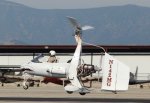- Joined
- Oct 30, 2003
- Messages
- 18,373
- Location
- Santa Maria, California
- Aircraft
- Givens Predator
- Total Flight Time
- 2600+ in rotorcraft
I had this question from a primary student with ten landings in his log book on his second visit for instruction.
I had not flown with him in several months so we spent .8 hours on ground reference maneuvers, debriefed and then briefed for takeoffs and landings.
We few patterns for an hour and made five landings and takeoffs flying a close pattern with an operating control tower.
On his last landing I could barely feel the touch down and the GPS had us a 3kts on touch down. This is what is known colloquially as a greaser.
This client is a tightly wound over achiever and feels frustrated because every landing is not a “greaser”.
As an instructor I am amazed at his progress and realize he has no one to compare his progress to.
It is my observation that the majority of gyroplane accidents happen during the takeoff and landing phases of flight.
I started to break it down, five landings in an hour or a landing every 12 minutes. How much time is actually spent landing from the round out to being stopped on the runway? Perhaps 20 seconds?
So with ten landings in his log book he has spent a total of 200 seconds (less than three and a half minutes) and he wonders why he hasn’t learned a task heavy and complex series of control inputs equal to someone with over 3,500 landings in his log book (about nineteen hours of landing experience).
Not all of my landings are greasers and every landing is different.
I continue to learn from every landing and every client.
I had not flown with him in several months so we spent .8 hours on ground reference maneuvers, debriefed and then briefed for takeoffs and landings.
We few patterns for an hour and made five landings and takeoffs flying a close pattern with an operating control tower.
On his last landing I could barely feel the touch down and the GPS had us a 3kts on touch down. This is what is known colloquially as a greaser.
This client is a tightly wound over achiever and feels frustrated because every landing is not a “greaser”.
As an instructor I am amazed at his progress and realize he has no one to compare his progress to.
It is my observation that the majority of gyroplane accidents happen during the takeoff and landing phases of flight.
I started to break it down, five landings in an hour or a landing every 12 minutes. How much time is actually spent landing from the round out to being stopped on the runway? Perhaps 20 seconds?
So with ten landings in his log book he has spent a total of 200 seconds (less than three and a half minutes) and he wonders why he hasn’t learned a task heavy and complex series of control inputs equal to someone with over 3,500 landings in his log book (about nineteen hours of landing experience).
Not all of my landings are greasers and every landing is different.
I continue to learn from every landing and every client.

